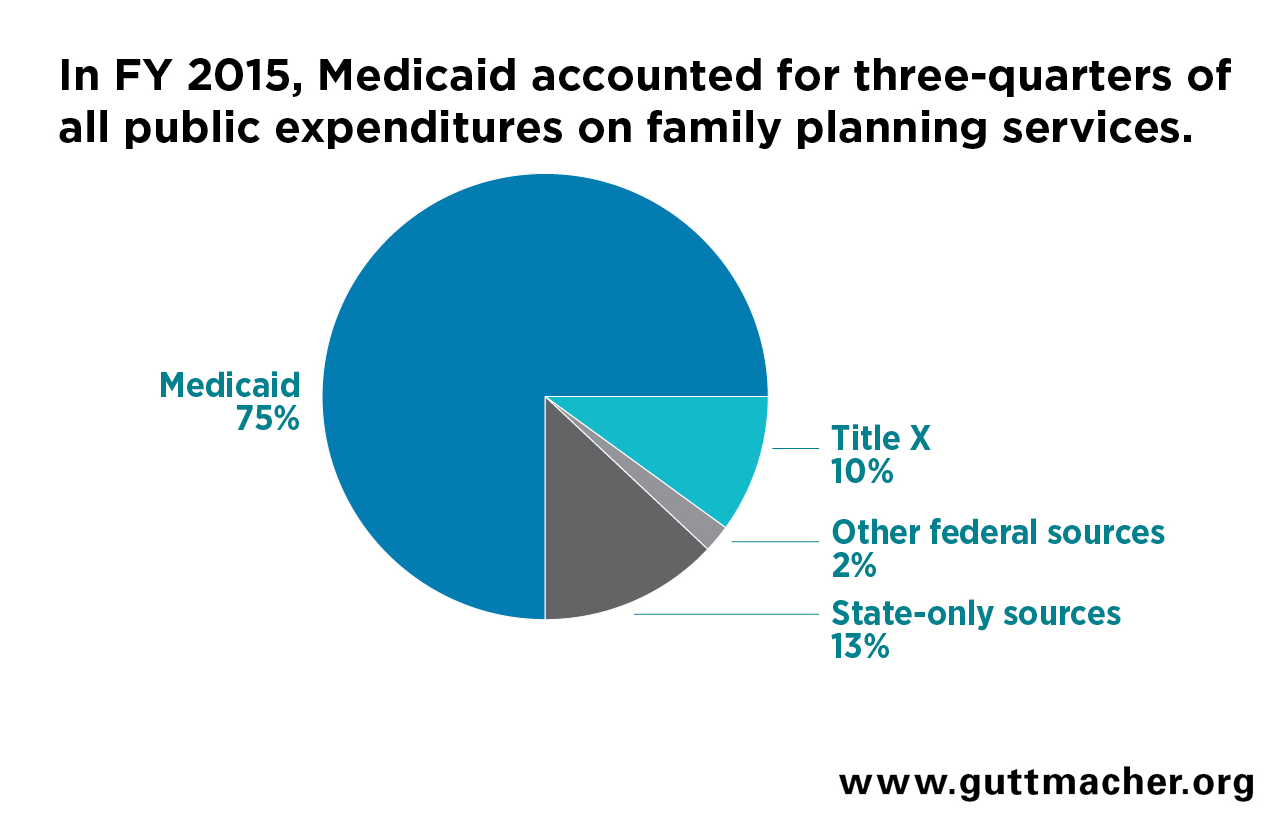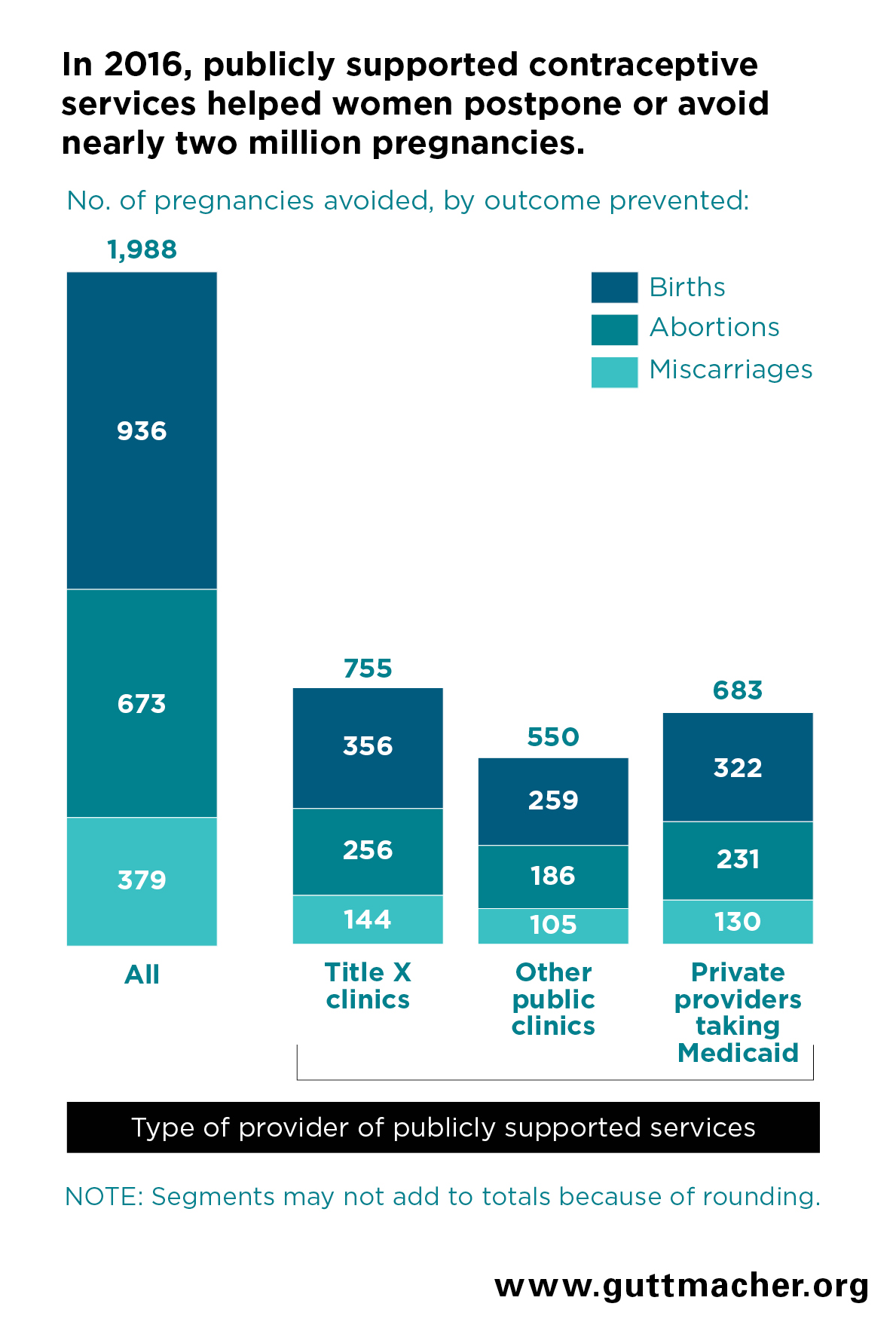LIKELY NEED FOR PUBLICLY SUPPORTED SERVICES
- There were 68 million U.S. women of reproductive age (13–44) in 2016, 21 million of whom were likely in need of public support for contraceptive services and supplies because they either had an income below 250% of the federal poverty level or were younger than 20.1
- Among the 21 million women with likely need for publicly funded services, 76% (16 million) were adults with incomes below 250% of the federal poverty level and 22% (4.6 million) were younger than 20.1
- Approximately 10.1 million of the women likely in need in 2016 were non-Hispanic white, 3.7 million were non-Hispanic black, 5.1 million were Hispanic, and the remaining 1.8 million women identified with other or multiple racial and ethnic groups.1
PUBLIC FUNDING AVAILABILITY
- Public expenditures for family planning services totaled $2.1 billion in fiscal year 2015.2
- The joint federal-state Medicaid program reimburses providers for contraceptive and related services delivered to enrolled individuals. By contrast, Title X of the Public Health Service Act, the only federal program devoted specifically to supporting family planning services, subsidizes services for women and men who do not meet the narrow eligibility requirements for Medicaid, maintains the national network of family planning clinics and sets the standards for the provision of family planning services.2
- Medicaid accounted for 75% of 2015 expenditures on family planning, state appropriations accounted for 13% and Title X for 10%. Other sources, such as the maternal and child health block grant, the social services block grant and Temporary Assistance for Needy Families, together totaled 2% of expenditures.2
WHO RECEIVES PUBLICLY SUPPORTED SERVICES
- In 2016, 9.3 million women—45% of all women who likely need public support for contraceptive services—were served by clinics (6.1 million) or private providers serving Medicaid enrollees (3.2 million).1
- In 2016, 1.2 million adolescent women were served by publicly supported clinics and 680,000 by private providers serving Medicaid enrollees.1
WHERE PUBLICLY SUPPORTED SERVICES ARE PROVIDED
- In 2015, 10,708 safety-net health clinics provided subsidized family planning services—5,829 (54%) were federally qualified health centers, 2,242 (21%) were health departments, 1,108 (10%) were independent clinics, 853 (8%) were hospital outpatient facilities and 676 (6%) were Planned Parenthood sites.3
- Nearly one-third (32%) of women who obtained contraceptive care from safety-net clinics in 2015 received services from Planned Parenthood sites, 30% from federally qualified health centers, 20% from health departments, 10% from hospital outpatient facilities and 8% from other independent clinics.3
- In 2015, 82% of U.S. counties had at least one safety-net health clinic providing family planning services.4
SERVICES PUBLICLY SUPPORTED CLINICS OFFER
- In 2015, more than three-quarters of clinics (77%) reported offering patients at least 10 of 13 reversible contraceptive methods.5
- Oral contraceptives, injectables (e.g., Depo-Provera) and condoms were provided by more than nine in 10 safety-net health clinics, and 85% offered emergency contraceptive pills.5
- Four in 10 clinics (42%) reported being unable to stock certain contraceptive methods due to cost.5
- As of 2015, clinics with a reproductive health focus offered a greater range of contraceptive methods on-site and were more likely to have protocols to help patients initiate and continue using methods, compared with clinics focusing on primary care.5
- In 2015, 52% of clinics offered same-day appointments for an initial contraceptive visit, and 42% of clinics offered some extended hours in the evenings or on weekends. Among all clinics, the average wait for an appointment was just over three days.5
- Virtually all publicly supported family planning clinics provided pregnancy testing in 2015, and the vast majority offered HIV testing (94%), testing for chlamydia or gonorrhea (98%), STI treatment (97%), and HPV vaccinations (90%).5
IMPACT OF FAMILY PLANNING SERVICES
- In 2016, women who obtained contraceptive services from all types of publicly supported providers were able to postpone or avoid two million pregnancies that they would have been unable to prevent without access to publicly supported care. These pregnancies could have resulted in some one million births and nearly 700,000 abortions.1
- Screening and vaccination services provided at family planning visits with all publicly supported providers helped patients avoid more than 12,000 cases of pelvic inflammatory disease and nearly 2,000 cases of cervical cancer in 2016. More than 100,000 chlamydia infections, 18,000 gonorrhea infections and 800 cases of HIV were prevented among the partners of women who obtained publicly funded contraceptive care that year.1
- Altogether, the services provided at publicly supported family planning visits in 2016 resulted in a net savings to the federal and state governments of $12 billion.1
- In 2016, every $1.00 invested in publicly funded family planning services saved $4.83 in Medicaid expenditures that would otherwise have been needed to pay the medical costs of pregnancy, delivery and early childhood care.1
The Title X National Family Planning Program
TITLE X–SUPPORTED CLINICS AND PATIENTS
- In 2018, there were nearly 4,000 Title X–funded clinics6 and they served 58% of all women who received contraceptive services at publicly funded clinics (3.5 million).1
- Among Title X–funded family planning clinics in 2015:
- Planned Parenthood sites represented 13% of clinics and served 41% of all contraceptive patients;
- Public health departments administered 48% of clinics and served 28% of patients;
- Federally qualified health centers accounted for 26% of clinics and served 19% of patients;
- Hospital outpatient sites represented 4% of clinics and served 5% of patients; and
- Other independent clinics accounted for 9% of clinics and served 7% of patients.3
- In 2015, 64% of U.S. counties had at least one Title X–funded clinic.4
- For most Title X patients (60%) surveyed in 2016, the Title X–funded site where they sought family planning care was their only source of broader health care over the past year.7
- Among the 71% of Title X patients surveyed in 2016 who reported having public or private health insurance, 83% planned to use it to pay for health care services. More than one‐quarter of patients not planning to use their existing insurance for services indicated the reason was concern that someone might find out they had received care.7
- In 2018, 65% of Title X patients had incomes at or below the federal poverty level and 40% were uninsured.6
SERVICES TITLE X–FUNDED CLINICS OFFER
- In 2016, Title X–funded clinics provided a wider range of contraceptive methods and were more likely to have protocols to enable easy initiation and continuation of methods, compared with clinics not receiving Title X funding.5
- Title X–funded health centers provide a range of related health services in addition to contraceptive care. In 2018, these sites delivered about 652,000 Pap tests, 816,000 breast exams, and 6.5 million tests for HIV and other STIs.6
- Although Title X–funded clinics typically focus on serving women, most offer services to men. For instance, 11% (some 450,000) of family planning patients served by Title X clinics in 2016 were male.8
IMPACT OF TITLE X–FUNDED SERVICES
- Women who obtained contraceptives from Title X–funded clinics were able to postpone or avoid some 755,000 pregnancies in 2016 that they would not have been able to prevent without access to publicly supported care.1
- Screening and vaccination services provided by Title X–funded clinics at family planning visits helped patients avoid an estimated 4,600 cases of pelvic inflammatory disease and 740 cases of cervical cancer in 2016. About 44,000 chlamydia infections, 7,200 gonorrhea infections and 370 cases of HIV were prevented among the partners of women obtaining Title X–supported contraceptive care.1
- The services provided at Title X–funded clinics in 2016 resulted in a net savings to the federal and state governments of $4.4 billion.1

